Graphene Nanoribbon Bending (Nanotubes): Interaction Force between QDs and Graphene
Peer reviewed, Journal article
Published version

View/
Date
2022Metadata
Show full item recordCollections
Abstract
Carbon materials in different shapes—such as fullerene molecules (0D), nanotubes and graphene nanoribbons (1D), graphene sheets (2D), and nanodiamonds (3D)—each have distinct electrical and optical properties. All graphene-based nanostructures are expected to exhibit extraordinary electronic, thermal, and mechanical properties. Moreover, they are therefore promising candidates for a wide range of nanoscience and nanotechnology applications. In this work, we theoretically studied and analyzed how an array of quantum dots affects a charged graphene plate. To that end, the array of quantum dots was embedded on the graphene plate. Then, considering the interaction between QDs and graphene nanoribbons, we transformed the charged plate of a graphene capacitor into a nanotube using the bipolar-induced interaction and the application of an external electromagnetic field. In this work, the dimensions of the graphene plate were 40 nm × 3100 nm. The bending process of a charged graphene plate is controlled by the induced force due to the applied electromagnetic field and the electric field induced by the quantum dots. Finally, using the predetermined frequency and amplitude of the electromagnetic field, the graphene nanoribbon was converted into a graphene nanotube. Since the electrical and optical properties of nanotubes are different from those of graphene plates, this achievement has many practical potential applications in the electro-optical industry.
